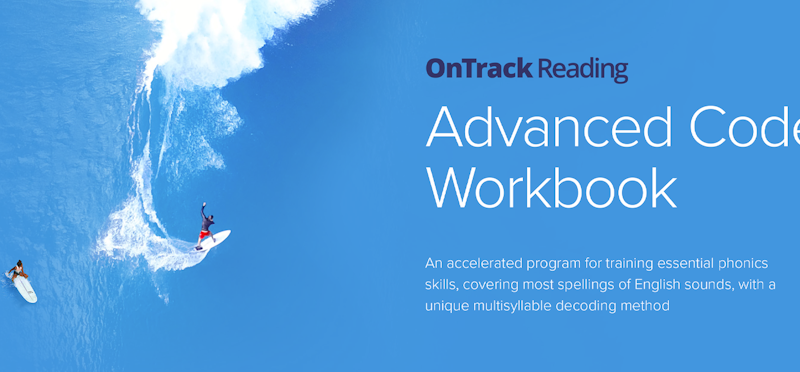The OnTrack Reading Multisyllable Method is free for you to use. It is a decoding strategy for reading multisyllabic words that struggling readers often attempt to read by guessing. This strategy teaches your child to read longer words by first breaking them up into chunks, and then efficiently testing the vowel sounds in each of the chunks. This overview describes the steps to implement the multisyllable curriculum. The associated worksheets and word lists are also free, and can be downloaded from the following pages as they are needed.
Should You Use Only the Multisyllable Curriculum?
This free multisyllable curriculum is part of the broader OnTrack Reading Phonics Program which is detailed in our Advanced Code Phonics Workbook and its accompanying Instruction Manual.
If your child is already familiar with the phonics code and can read one-syllable words fluently without sounding them out one by one, you might consider bypassing the workbook. Instead, focus on the OnTrack Reading Multisyllable Method presented in the following pages. (See the sidebar menu for an overview of the topics covered.)
How Can I Determine if My Child Knows Enough Phonics to Skip the Workbook?
If you're uncertain, take advantage of the free Phonics Assessment Tests offered on this site, particularly the Code Knowledge Test. This will indicate if your child has a strong grasp of the English phonics code, potentially allowing them to bypass the workbook.
However, if your student has difficulty reading basic one-syllable or two-syllable words, or isn't confident with words featuring vowel digraphs (like ow, ou, ea, ie, oy, oi, etc.), it's recommended to use the workbook. It offers a thorough foundation in phonics and covers the essential phonemic skills of blending, segmenting, and phoneme manipulation.
The Logic Underlying the Design of the Multisyllable Curriculum
A few years back, someone posted a comment about verbal syllables on a website that I found interesting. The comment: Linguists recognize that a natural break in spoken syllables normally occurs immediately after the vowel sound. Essentially, I took that comment and developed a multisyllable decoding method around it. I’ve used the resulting method with almost 200 clients since then, fine-tuning it as I went. It works exceptionally well because it's based upon what a child actually hears when a word is pronounced.
All that is required of a child is to apply a single rule to break a multisyllable word down into something approaching syllables, while applying three easy-to-learn exceptions, and to then learn to test various options for the vowel sounds in a systematic manner. This process is described in detail on the next pages, but first it's helpful to understand why present methods are so confusing to many children, and especially to struggling readers.
The Problem with Traditional Syllables
Where most multisyllable instruction goes awry is in adopting the written syllables as they have long been defined in Webster's dictionary. Unfortunately, Noah Webster made some poor decisions when it came to how he arbitrarily set syllable boundaries, decisions that have only recently begun to be reversed. The result of one such decision leads many curriculum designers to try to teach a young child to break syllables in words like rabbit and common between the doubled consonants, resulting in rab-bit and com-mon. In fact, there is only one /b/ sound in rabbit and one /m/ sound in common and it is potentially confusing to a young child to be told that he should be hearing two.
Webster also insisted on forming syllables based on whether they should be open or closed. A closed syllable has a consonant sound following a short vowel sound, whereas an open syllable ends with a long vowel sound. As a result, many curriculum designers expect a child to know that vapor is broken into two as va-por, but that rapid is rap-id. They explain that closed syllables carry short vowel sounds, and open syllables carry long vowel sounds. What's left unexplained is how to determine whether to close any particular syllable or leave it open, as well as what to do about words like father (fa-ther) where the vowel sound is neither long nor short. Needless to say, such an approach can confuse a first grader.
The Natural Break: After the Vowel Sound
In fact, the natural break in the spoken words, using the above examples, is after the vowel sound in each case (ra-bbit, co-mmon, va-por, ra-pid and fa-ther.) To convince yourself of this, just read the five words out loud, pausing very briefly at each break as indicated. Do this two or three times to feel the natural cadence. Now read these dictionary defined breaks (rab-bit, com-mon, va-por, rap-id, fa-ther.) Notice how awkward it is to pause on three of the examples now? This is because the natural spoken syllable break is after the vowel sound.
One important exception occurs, however. When the next spoken syllable would have to begin with an awkward blend, one or even two consonant sounds are naturally tacked on to the preceding syllable. Thus, constant is broken in spoken syllables not as co-nstant, but rather as con-stant because nst is not a permitted blend in English. Sometimes two sounds have to be moved, as with gently. It breaks apart naturally not as ge-ntly nor as gen-tly, but as gent-ly, because neither ntl nor tl are permissible beginning blends in English words.
These breaks happen quite naturally in spoken syllables because only a limited number of specific consonant combinations are used to begin English words, and this limitation extends to the internal syllables as well. Any child, even though completely unaware of syllable rules, will tend to naturally chunk constantly as con-stant-ly once he knows what you mean by asking him to break the word up into chunks. Co-nsta-ntly will never occur to him, nor will con-stan-tly.
The OnTrack Reading Method Uses Chunks, Not Syllables
For instructional purposes, it wouldn’t do to redefine the word syllable for each child. And we are talking about spoken syllables anyway, so the way to handle it is to define a new word that means chunks of sound, and that word in this curriculum is just chunk. You just explain to your child that longer words are composed of chunks, illustrate the concept, and then mention that if he ever takes a syllable test and uses chunks instead he will fail it.
My students learn that longer words are composed of several chunks and that each chunk has exactly one vowel sound in it. This is the one thing chunks and syllables have in common; each has exactly one vowel sound, so a five syllable word will have exactly five vowel sounds and it will divide into exactly five chunks
Support for Chunking from an Unexpected Source
Unlike all previous editions, The Merriam-Webster Dictionary, 11th Edition, copyright 2005, supports the above chunking strategy to a large degree. The pronunciations of the above examples, rabbit, common and rapid, now show the breaks at ra-bbit, co-mmon and ra-pid. (The syllable breaks remain unchanged; it's the pronunciation guide that follows each word that has changed.) The only discrepancy I can now find between the natural linguistic break and the Merriam-Webster pronunciation guide occurs when a chunk begins with one of the blends beginning with the letter s, such as sc (mas-cot), sk (mus-ket) and st (cas-ting) and then only when the blend is preceded by a short vowel sound. I will leave it to the reader to decide whether or not a child will get the correct word if he chunks them ma-scot, mu-sket and ca-sting, respectively, assuming that he does as instructed and tries First Vowel Sounds (short vowel sounds) on his first attempt at each word.
The next page describes The Main Rule and Three Exceptions that form the basis of the OnTrack Reading Multisyllable Method.



